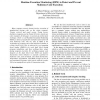Free Online Productivity Tools
i2Speak
i2Symbol
i2OCR
iTex2Img
iWeb2Print
iWeb2Shot
i2Type
iPdf2Split
iPdf2Merge
i2Bopomofo
i2Arabic
i2Style
i2Image
i2PDF
iLatex2Rtf
Sci2ools
ICCD
2004
IEEE
2004
IEEE
Runtime Execution Monitoring (REM) to Detect and Prevent Malicious Code Execution
1 Many computer security threats involve execution of unauthorized foreign code on the victim computer. Viruses, network and email worms, Trojan horses, backdoor programs used in Denial of Service attacks are a few examples. In this paper, we present an architectural technique, which we call Runtime Execution Monitoring (REM), to detect program flow anomalies associated with such malicious code. The key idea in REM is the verification of program code at the hash block (similar to a basic block) level. This is achieved by pre-computing keyed hashes (HMACs) for each hash block during program installation, and then verifying these values during program execution. By verifying program code integrity at the hash block level, REM can monitor instructions whose behavior is typically exploited by malicious code, such as branch, call, return instructions. Performance degradation with REM averages 6.4% on our benchmark programs, which can be reduced to under 5% by increasing the size of the L1 ...
| Added | 16 Mar 2010 |
| Updated | 16 Mar 2010 |
| Type | Conference |
| Year | 2004 |
| Where | ICCD |
| Authors | A. Murat Fiskiran, Ruby B. Lee |
Comments (0)

